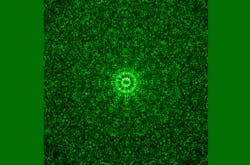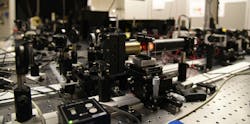Novel quasicrystal design further ‘green lights’ topological study of light
Aalto University researchers in Finland believe a novel quasicrystal-based method they developed to create light vortices may one day enable an entirely new way to encode and transport large amounts of data (see video).
Professor Päivi Törmä’s Quantum Dynamics group explores metallic nanoparticles that interact with an electromagnetic field (plasmonics). The theoretical framework for the quasicrystal design method was developed by Kristian Arjas, a doctoral researcher, and was experimentally achieved by Jani Taskinen, who was finishing his Ph.D.
The group’s work was inspired by an earlier study of theirs, in which they found they could select a specific vortex for lasing within periodic structures by placing nanoparticles in specific positions. But only a few different vortices were available due to the geometric constraints—and getting more vortices meant moving into the realm of quasicrystals (aperiodic, but ordered structures) where higher rotational symmetries exist.
“Like many great ideas, the quasicrystal structures were originally an attempt to solve an entirely different problem related to magnetic materials. While this project never came to fruition, Arjas’s creativity allowed us to leverage tools learned along the way to generate these unprecedented plasmonic devices,” says Taskinen.
Lasing within plasmonic nanoparticle lattices isn’t new. “Such devices represent one form of distributed-feedback lasers where a periodic structure supports a standing wave,” says Taskinen. “These modes can then be amplified by adding a gain material and external pumping. For our work, we combine two-dimensional (2D) devices with dye molecules and pump them optically with another laser. The amplified waves are plasmonic excitations—quasiparticles composed of electromagnetic waves and electron oscillations on the surface of the nanoparticles.”
The tricky part is designing the lattice geometry so plasmonic modes generate laser beams with polarization vortices, and this is where the group’s novel quasicrystal design process becomes crucial.
“We can tell which vortices are present from the sample’s symmetry,” says Arjas. “Quasicrystals give us more options (and more complex vortices) due to their higher degree of rotational symmetry. But it comes at the cost of long-range order, which is a necessity for providing a strong enough feedback mechanism for plasmonic lasing. The problem becomes two-fold: how to select a specific mode from many modes with similar energies and how to make it lase.”
Symmetry “is one of the few things nature must respect,” Arjas points out. And it just so happens to be what allowed the researchers to connect different theoretical models to each another and to experiments.
“Our quasicrystal design process can be useful for many other photonic applications beyond plasmonics,” says Taskinen. “The mode selection was driven by spatially applied plasmonic losses, but nothing prohibits the use of localized gain structures to achieve a similar result. It goes to show sometimes losses within an optical system can be useful.”
Design process
From a theoretical standpoint, the group’s design process consisted of three steps: Identifying dead spots within the electric field and placing particles there; introducing long-range order within the system to enable standing waves, which is a necessity for plasmonic lasing; and, finally, adding finishing touches to make the sample as uniform as possible to avoid any unwanted effects.
“The design was done in quick iterative cycles in close collaboration with Taskinen, so I could make a set of initial theory-based designs that he would finalize based on his experience with plasmonic systems,” says Arjas. “He then fabricated and measured the structures and gave me the data, which I used to refine the theoretical model for the next iteration. We went through this cycle about eight times.”
Plasmonic structures are “inherently lossy and, while this property allows us to implement the quasicrystal design process, it hinders the quality of the lasing modes,” explains Taskinen. “Experimentally, the work was very much a balancing act between two principles: having enough nanoparticles in the quasicrystal to enforce mode selectivity while keeping the overall losses small enough to support lasing.”
In the end, many of the correct quasicrystal parameters could be found only by trial and error, which involved multiple rounds of sample fabrication within cleanroom conditions and lasing measurements within the optics lab. “To explore the optical properties of these devices, we pumped the samples with ultrafast laser pulses and analyzed the emission with an angle-resolved spectrometer setup,” says Taskinen.
Challenges and a surprise
From a theoretical perspective, the group’s primary challenge was figuring out how to model the structure.
“For periodic structures, it’s enough to do the calculations for the part that repeats and then go from there,” says Arjas. “But the lack of periodicity within our structure threw this approach out the window and we had to find a way to model the entire structure simultaneously. This, combined with the fact that plasmonic lasing typically requires roughly 100,000 interacting particles within a single sample, put computational complexity with standard methods far beyond our reach.”
They sidestepped the problem by simply ignoring particle-particle interactions. Metallic particles within an oscillating electric field act as dampeners because part of the energy gets transformed into heat. After figuring this out, it was simple for the team to find a good approximation of the field seen by the nanoparticles corresponding to the desired vortex. Then, they placed particles where the field showed the least activity (the smallest losses).
“The parameter space of plasmonic lasers sometimes seems overwhelming, so we need a certain ‘feel’ to the experiments to see the correlations between different lattice designs, adjustments to the optical setup, and the resulting emission properties,” says Taskinen. “At some point, the measurements tend to become an optimization problem to solve in a pitch-black optics lab with a screwdriver, which can be surprisingly fun.”
After they managed to get the method working for vortices in 8- and 10-fold rotationally symmetric structures, Arjas decided to generate a structure with a 12-fold rotational symmetry (because why not!). Taskinen prepared the sample and measured its lasing properties successfully on the first try, and they were both awestruck when the data showed far more intricate behavior than they’d expected—multiple different vortices and clear transitions between them. As far as they’re aware, this was the first time anything like it was observed within a beam of light—particularly a beam of laser light generated from a single structure.
Advance for telecom
The most obvious application ahead for the team’s discovery is telecommunications.
“Information is encoded into pulses of light in what physicists call degrees of freedom,” says Arjas. “These are different aspects of light you can manipulate, such as wavelength (color), phase, polarization, or brightness, to name a few. The more of these you can encode into a single packet, the more information you can send via a single pulse. These vortices could provide an additional piece of information sent with each package, and the amount of extra information depends on how many different vortices can be included.”
The group’s vortices can potentially be sent down fiber-optic cables and unpacked at their destination. It would enable storing information in a much smaller space and transmitting much more of it at once. How much more? Perhaps 8 to 16x the amount we can currently deliver via fiber-optic cables.
And since the team’s pioneering work is a general design method for 2D optical devices, “it can be applied to a plethora of systems within the field of photonics,” Taskinen adds.
Plasmonic devices ahead?
Next up, Arjas is pursuing more exotic topological phenomena on these plasmonic lattices during the remainder of his Ph.D. studies with Professor Törmä.
This work was the finale of Taskinen’s Ph.D. studies and, although he’s moved on to an entirely different topic, the Quantum Dynamics research team continues to explore plasmonic devices. Beyond topological effects, the team has begun exploring plasmonic applications—focusing on improving the efficiency of organic light-emitting diodes using metallic nanostructures—and topological features may also prove to be useful for this endeavor.
FURTHER READING
K. Arjas et al., Nat. Commun., 15, 9544 (2024); https://doi.org/10.1038/s41467-024-53952-5.
About the Author
Sally Cole Johnson
Editor in Chief
Sally Cole Johnson, Laser Focus World’s editor in chief, is a science and technology journalist who specializes in physics and semiconductors.



